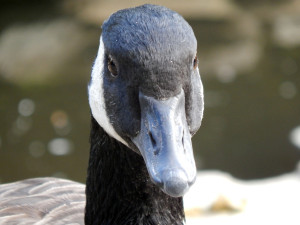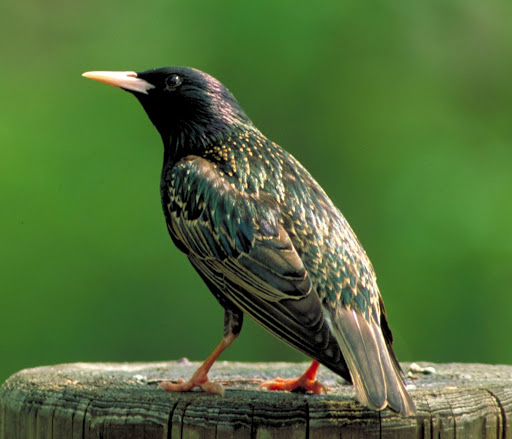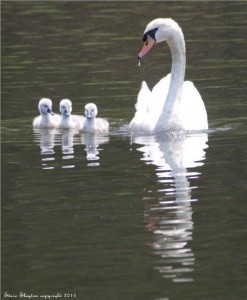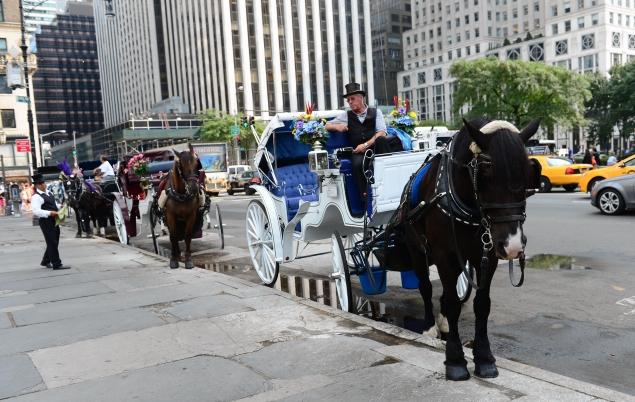The Mute Swan is a living picture of beauty with its long elegant necks and snow white plumage. It is often considered a symbol of fertility and love but to the New York State Department of Environmental Conservation, they are an invasive species.
A proposal by the DEC is calling to eliminate all of the 2,200 free-range mute swan population by 2025. The draft report outlines that the swans are potential aviation hazards, contribute to loss of water quality from coliform bacteria, and are aggressive towards humans and other waterfowl. These same reasons were given when Canadian Geese, a native North American species, were deemed a “nuisance” and slaughtered to the tune of 5,000 in New York City. Methods to eliminate the swans are through nest/egg termination (by egg oiling to prevent hatching) and shooting or gassing of adult birds.

Canadian Goose
(Photo c/o Jessica DePoalo @ Flickr)
The Mute Swan was first brought to the United States from Europe in the late 1800s for rich aristocrats who valued their ornamental style for their private estates or zoos. Around 1919 a small number of the swans escaped into the wilds of New York, where they continue to live.
Studying the reports by the DEC shows contradictory language and inconclusive findings in their justification of killing an entire mute swan population in New York. One of the reports (Management Plan for Mute Swans in New York State) claim that the largest mute swan population is in Lake Ontario and that their numbers have increased dramatically during the last decade. However, another report (Status and Ecology of Mute Swans in New York State) describes the Lake Ontario swans as, “relatively small” and goes on to admit that, “due to small sample sizes, the data we collected did not allow us to calculate productivity and survival for each region of the state.” Additionally, this same report went on to say that the total number of the mute swan population is stable with a decrease of 2.5-3.0% per year.
Along with the reasons stated above in justifying their proposal, the report discusses population control while still being accepting of breeders who breed the swans. It states that commercial breeders can sell a single swan for $200 while a breeding pair of swans can go for more than $1,500. It goes on to say that some hunters have expressed an interest in hunting mute swans and that this, “could be an effective way to help reduce the free-ranging population in some areas,” It appears that due to this, the DEC will allow people to obtain a Game Bird Breeder license which would be contradictory to any efforts of population eradication for the mute swans and only serve the continued interests of a group of hunters.
Both reports mention that mute swans are aggressive towards humans, especially small children, and can make areas inaccessible for people. Specifically the reports mention their aggression in defense of nests or offspring. “Attacks on personal watercraft, or non-motorized boats, and intimidating approaches toward people on land, occur almost every year.” says one report. However, none of the reports actually list how many injuries or attacks on humans have occurred over any time period. They do cite a report by the Department of Environmental Management of Rhode Island which does state that 11 recorded incidents of mute swan interacting with humans (which is very loose terminology) occurred between 1976-2003.
It is odd that the DEC would focus on the mute swan, especially considering that there are many animals within the United States and New York that are considered invasive. Birds that New Yorkers see on a daily basis like the Rock Dove (otherwise known as Pigeon’s), European Starling, House Sparrow, and House Finch are all considered invasive species. Many of these birds have been around New York for centuries, adapting and becoming a part of both the urban and rural environments. So the question becomes, why would the DEC want to exterminate the entire mute swan population now after it has lived in New York for about 150 years? There are no definite answers for that question except what comes from the reports, which are contradictory and lack proof.

60 European Starling’s were released in Central Park by Eugene Schieffelin in 1890. (Photo c/o Eco Brooklyn Inc.)

The House Sparrow was introduced in the 1940’s and sold illegally in NYC as “Hollywood Finches”. To avoid prosecution, owners and sellers released the birds. (Photo c/o ephemeralnewyork)
Even for those who are not concerned about the well-being and life of the mute swan should consider that this proposal, if put into action, will be using taxpayer dollars. If there is nothing else left to convince people to be against this proposal, then they should really ponder this: there was a management plan formed by the DEC in 1993 to reduce the population to 500 mute swans by 2013 that failed because, “our current management policy has not been effective in reaching that goal because relatively little action was taken.” To put it simply, the DEC failed to implement and monitor their own plans.
Luckily, State Assemblyman Fred Thiele Jr. (I-Sag Harbor), State Assemblyman Steve Cymbrowitz (D-Brooklyn), and Senator Tony Avella (D-Queens) have co-sponsored legislation (S.6589/A.8790) that would put a two-year delay on the DEC’s proposed plan and make the department demonstrate further proof that the mute swans cause damage to other species and the water.
The DEC is accepting public comments to its mute swan proposal through Feb. 21 by email at fwwildlf@gw.dec.state.ny.us or by mail at NYSDEC Bureau of Wildlife, Swan Management Plan, 625 Broadway, Albany, NY 12233-4754.
Animal-rights group GooseWatch NYC also started a petition against the DEC’s plan and can be signed here.


















Follow Us